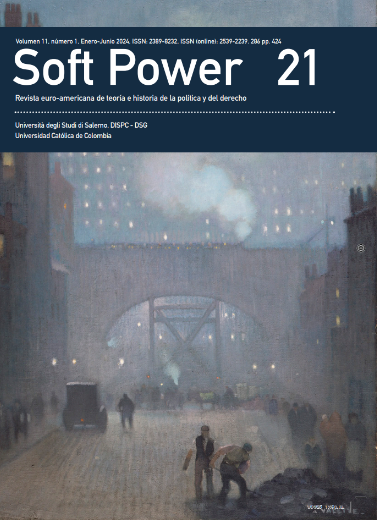
Este trabalho está licenciado sob uma licença Creative Commons Attribution-NonCommercial 4.0 International License.
Al enviar los artículos para su evaluación, los autores aceptan que transfieren los derechos de publicación a Soft Power. Revista Soft Power para su publicación en cualquier medio. Con el fin de aumentar su visibilidad, los documentos se envían a bases de datos y sistemas de indización, así mismo pueden ser consultados en la página web de la Revista.Resumo
The purpose of this paper is to examine and discuss the implications of current rearmament, with a particular emphasis on the EU's initiative for a common defence policy. The ongoing and escalating conflict between Russia and Ukraine has refocused the commitment of European governments and the attention of public opinion on military spending. Notably, defence budgets have been rising significantly. Data from the European Defence Agency (EDA) in 2022 revealed a 6% increase in defence spending compared to the previous year, marking the eighth consecutive year of growth. Since 2022, the conflict between Russia and Ukraine has heavily influenced public discourse, often cementing certain arguments and beliefs without critical examination. This paper aims to analyse three commonly presented theses in greater detail. The first thesis posits that the rearmament announced by various European governments will not only enhance the security of their countries but also contribute to winning the ongoing war by providing military support to Ukraine. The second thesis can be summarized by the phrase "more is better," implying that larger armies and arsenals ensure greater security. The third thesis argues that the current rearmament approach, which focuses on strengthening existing national defence systems, is the best or only possible method. This perspective overlooks potential alternative arrangements, such as an integrated EU defence structure, suggesting that the consolidation of national defence systems would be the optimal choice.

Referências
Caruso R. (2007). Continuing Conflict and Stalemate: A Note. Economics Bulletin, 4(17), 1–8.
Caruso R., Jun, X. (2017). War, Stalemate and Military Spending. Paper presented at the 2016, American Economic Association Meeting.
Fontanel, J., Smith, R. (1991). A European Defence Union? Economic Policy, 13(3), 393–425.
Guyot, M., Vranceanu, R. (2001). European defence: the cost of partial integration. Defence and Peace Economics, 12(2), 157–174.
Hartley K. (2020). Trans-European arms companies and industries. En The Economics of the Global Defence Industry. Routledge.
Hartley, K. (2003). The future of European Defence Policy: An Economic Perspective. Defence and Peace Economics, 14(2), 107–115.
Hirshleifer J. (2001). The Dark Side of the Force, Economic Foundations of Conflict Theory. Cambridge University Press.
Kleczka, M., Vandercruysse, L., Buts, C., & Du Bois, C. (2023). The Spectrum of Strategic
Autonomy in EU Defence Supply Chains. Defence and Peace Economics, 35(4), 427–447. https://doi.org/10.1080/10242694.2023.2180588
Kollias, C. (2008). A Preliminary Investigation of the Burden Sharing Aspects of a European Union Common Defence Policy. Defence and Peace Economics, 19(4), 253–263.
Intriligator M.D., e Brito D.L. (1984). Can Arms Race lead to Outbreak of war? Journal of Conflict Resolution, 28(1), 63-84.
Maoz, Z. 2005. Dyadic MID Dataset (version 2.0). http://psfaculty.ucdavis.edu/zmaoz/ dyadmid.html.
Nakao, K. (2020). Rationalist Explanations for Two-Front War. Peace Economics, Peace Science and Public Policy, 26(4).
Quackenbush, S. L. (2006). Not Only Whether but Whom: Three-Party Extended Deterrence. Journal of Conflict Resolution, 50(4), 562-583.
Schelling T. C., & Halperin M. H. (1961). Strategy and Arms Control. Twentieth Century Fund.
Skaperdas, S. (1992). Cooperation, Conflict, and Power in the Absence of Property Rights. American Economic Review, 82(4), 720-739.






